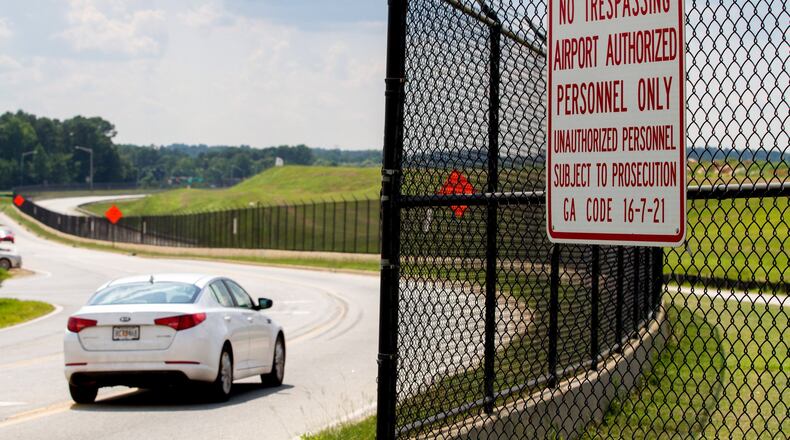Two security breaches in two weeks have highlighted a weak point at Hartsfield-Jackson International: the 29.5 miles of security fencing surrounding the world's busiest airport.
After the second incident in which a trespasser got past a fence to enter off-limits areas at Hartsfield-Jackson International, airport officials faced questioning from Atlanta city council members who are on the transportation committee that oversees the airport.
While the first incident was caught on closed circuit television, Hartsfield-Jackson interim general manager Balram Bheodari acknowledged that there are parts of the airport perimeter that are not monitored by CCTV.
No footage of the second incident was found Tuesday, according to Bheodari. Police and airport security officials are trying to determine how the breach occurred.
Airport officials are also working with the U.S. Department of Homeland Security to do a “deeper dive” to see if there is any connection between the two incidents, Bheodari said.
“It’s very scary, and they definitely need to do something,” said transportation committee member Carla Smith. The airport “is one of the places that we cannot take any chances,” she said.
The latest incident occurred at around 2 a.m. Tuesday morning. An airport maintenance worker spotted the intruder, later identified by police as E'Donis T. Andrews, 22. Andrews was taken into custody and charged with criminal trespass. He had minor cuts and "appeared to be under the influence of alcohol," according the police.
Two weeks ago, a different man scaled a razor-wire fence and ran onto an active taxiway, toward a plane, according to police. The incident, which temporarily halted some flights, was documented by the plane's passengers, who posted photos and video of the man wearing only underwear outside the aircraft.
“I hope this is not becoming a pattern,” Smith said. “This latest incident is making it a concern.”
Bheodari said the airport plans to increase the number of zones for surveillance from three to four. The airport inspected the entire fenceline Tuesday and did not find any hole or entryway an intruder may have used.
Hartsfield-Jackson security director Jan Lennon said the airport is looking at structural improvements to the fencing, like putting cement under more fencing to prevent people from crawling underneath and a mesh overlay to prevent people from climbing up.
The airport is also considering technology to detect intruders, such as infrared motion detection or radar sensors that can trigger an alarm if someone climbs a fence.
Other airport officials around the country “are talking about this,” said Bheodari, who added that he is also looking at security used at military installations and prison facilities.
Bheodari said he has visited Israel to look at airport security there. “Even with motion sensors, people were still able to breach” the perimeter, and false alarms triggered by animals or other movement could be an issue, he said.
“Can we ever prevent these things? I don’t know,” Bheodari said.
The airport reviewed the possibilities for technological improvements two years ago and made a decision to enhance security, according to Lennon, but is not yet ready to disclose what improvements are planned.
A national review of airport perimeter security breaches by the Associated Press in 2016 found that such incidents happen about once every 10 days.
“This sort of thing happens at all airports,” said Doug Laird, a security consultant and president of Laird & Associates. “But there are so many layers of security, generally the people don’t get very far.”
Airport workers in secure areas are trained to challenge those they see without badges displayed and report incidents.
With the airport operating 24 hours a day and workers around the airfield, “it’s very hard not to see something, because you have employees everywhere,” Lennon said.
“What we do is when we have an incident, we are very good at response. We are very good at recovering,” Lennon said.
Creating a physical barrier to prevent any intrusion is a challenge, Laird said. “If you have trained professionals” like Navy SEALs, “they can scale any fence within a couple of minutes,” he said. In other instances, people use tools to cut through fences.
“It’s just literally impossible to build a fence that keeps somebody who knew how to do it from going over,” Laird said.
About the Author
Keep Reading
The Latest
Featured




